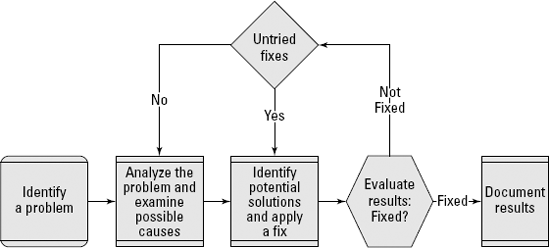2.1. Using Troubleshooting Procedures and Good Practices
Many people say that troubleshooting skills cannot be learned, but this is not true. If you are methodical or just very curious, you will probably have an easier time troubleshooting. However, anyone can learn the practical order to follow when troubleshooting problems. Follow the steps in this chapter, and you should have an easy time when it comes to troubleshooting.
The two main sections of troubleshooting are hypothesis generation and hypothesis evaluation. In other words, based on the symptoms that you see, you create a list of things that might be wrong and then test to see whether any of them are actually the problem. Figure 2-1 shows a rough outline of general troubleshooting procedures.
NOTE
On the exam, some of the CompTIA terminology might vary from what I use here, but the general guidelines and approximate order will remain the same.
Figure 2.1. Basic troubleshooting steps.

To troubleshoot any system, you need to know how that system is supposed to function and what options can be changed or might fail. This information allows you to quickly assemble a list of hypotheses. The better you know the system, the easier this phase will be. You then need to test these hypotheses. Testing might involve using tools appropriate to the system to test the condition of certain components, or it might involve changing a ...
Get CompTIA A+® Certification All-In-One For Dummies®, 2nd Edition now with the O’Reilly learning platform.
O’Reilly members experience books, live events, courses curated by job role, and more from O’Reilly and nearly 200 top publishers.

